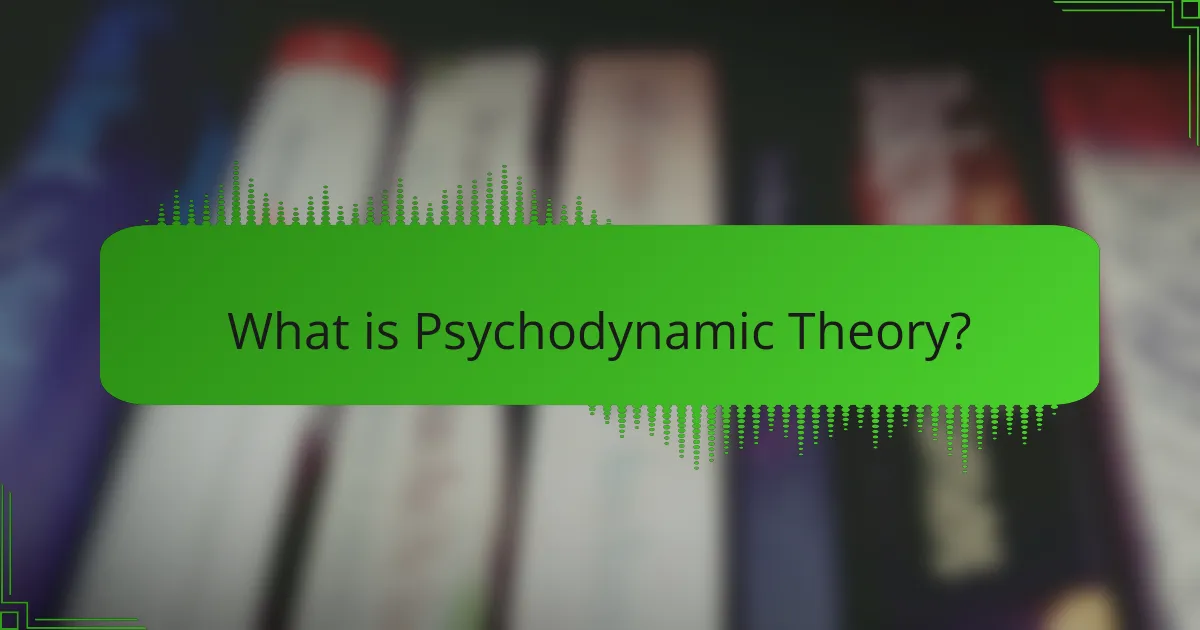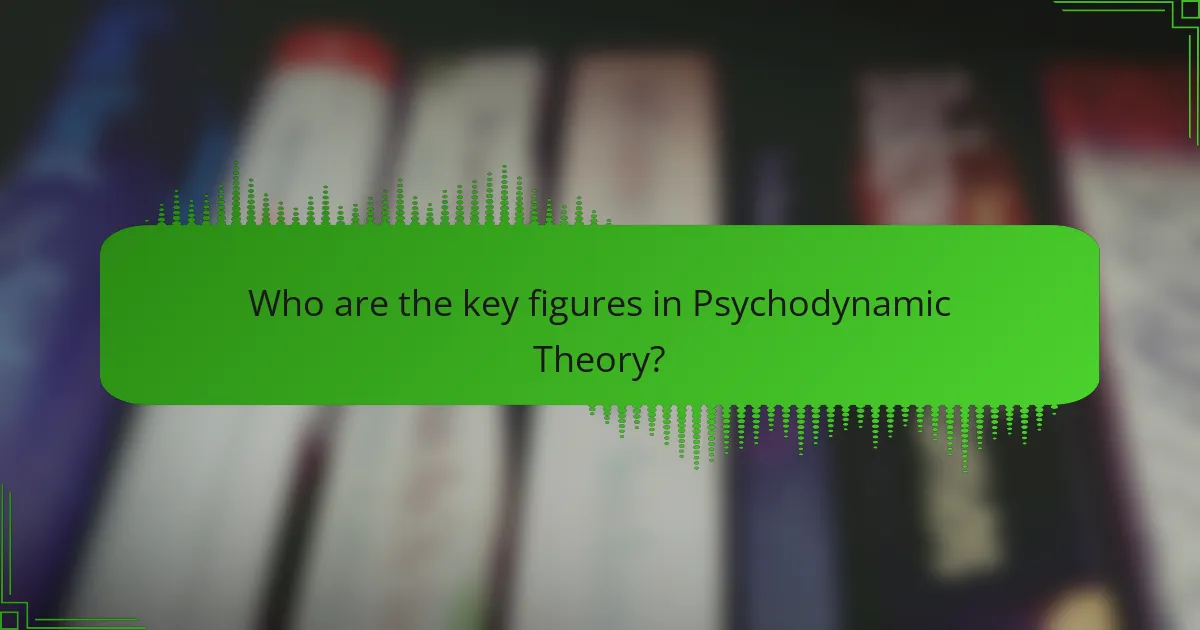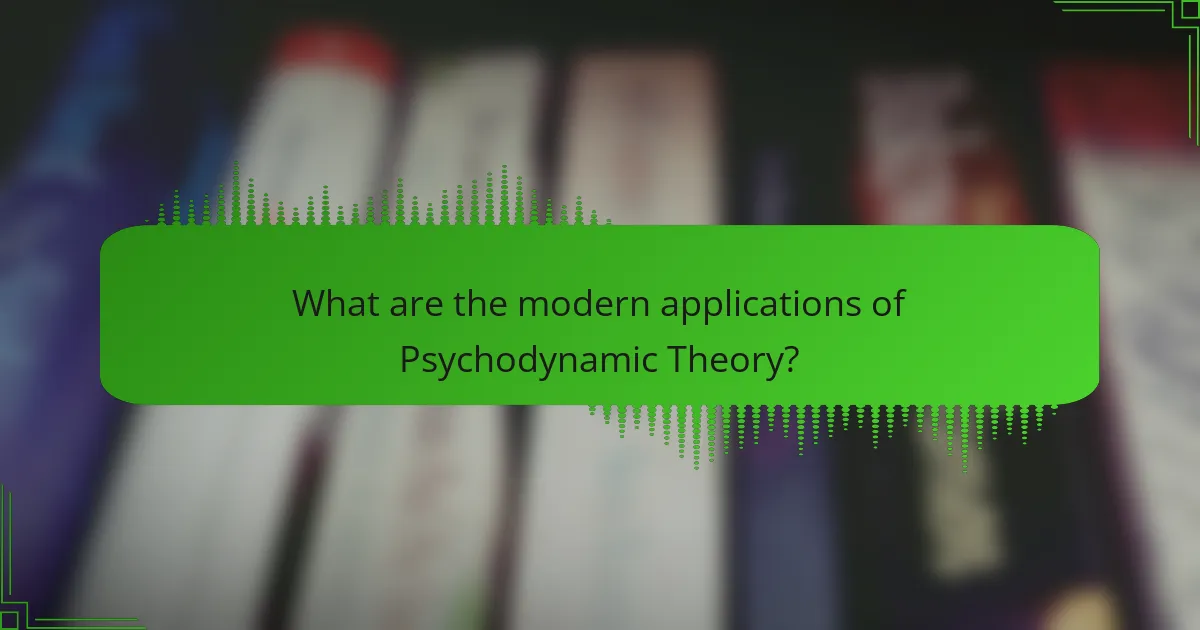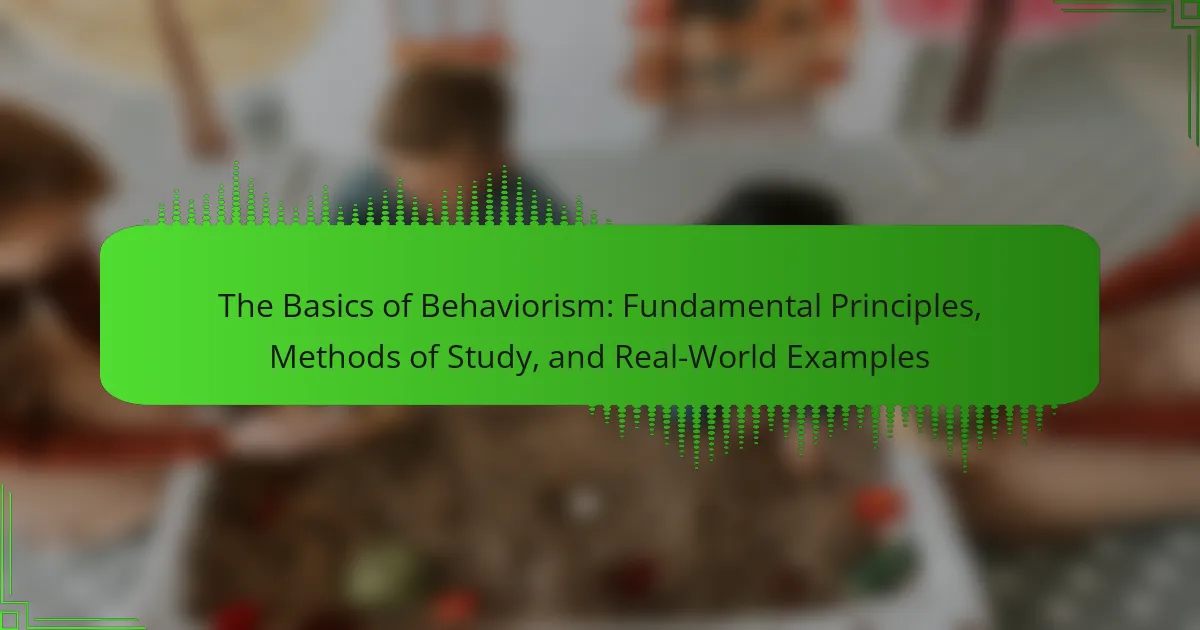Psychodynamic theory is a psychological framework developed by Sigmund Freud that emphasizes the impact of the unconscious mind on human behavior. This theory asserts that early childhood experiences significantly influence personality and behavior, while also highlighting internal conflicts and defense mechanisms. Key figures such as Freud, Carl Jung, and Melanie Klein have contributed foundational concepts that remain relevant in understanding mental processes. Psychodynamic therapy aims to uncover unconscious motivations and is effective in treating various mental health issues. The theory’s modern applications extend beyond psychotherapy to organizational behavior and educational settings, showcasing its versatility and ongoing significance in contemporary psychology.

What is Psychodynamic Theory?
Psychodynamic theory is a psychological perspective that emphasizes the influence of the unconscious mind on behavior. It was developed by Sigmund Freud in the late 19th century. This theory posits that early childhood experiences shape personality and behavior. It also highlights the role of internal conflicts and defense mechanisms. The unconscious mind contains thoughts and memories that are not accessible to conscious awareness. Psychodynamic therapy aims to bring these unconscious processes to light. Research indicates that psychodynamic approaches can be effective in treating various mental health issues. Studies have shown improvements in symptoms for patients undergoing psychodynamic therapy compared to control groups.
How did Psychodynamic Theory originate?
Psychodynamic Theory originated from the work of Sigmund Freud in the late 19th century. Freud developed this theory to explore the unconscious mind’s influence on behavior. He introduced concepts like repression, defense mechanisms, and the significance of early childhood experiences. Freud’s clinical observations of patients led him to propose that unresolved conflicts drive psychological distress. The theory evolved through the contributions of other psychologists, such as Carl Jung and Alfred Adler, who expanded on Freud’s ideas. Psychodynamic Theory remains influential in understanding human behavior and mental processes today.
Who are the key figures in the development of Psychodynamic Theory?
The key figures in the development of Psychodynamic Theory include Sigmund Freud, Carl Jung, and Alfred Adler. Sigmund Freud is the founder of psychodynamic theory. He introduced concepts such as the unconscious mind, defense mechanisms, and psychosexual stages of development. Carl Jung expanded on Freud’s ideas, introducing concepts like the collective unconscious and archetypes. Alfred Adler focused on individual psychology and the importance of social interest. These figures significantly shaped the understanding of human behavior and mental processes within the psychodynamic framework.
What are the foundational concepts of Psychodynamic Theory?
The foundational concepts of Psychodynamic Theory include the unconscious mind, defense mechanisms, and the significance of childhood experiences. The unconscious mind holds thoughts and memories that influence behavior. Defense mechanisms are psychological strategies used to cope with anxiety and protect the self. Childhood experiences shape personality and can impact [censured] behavior. Sigmund Freud, the founder of this theory, emphasized these concepts in his work. His theories highlight the interplay between the conscious and unconscious mind. Research supports the idea that early experiences affect emotional development. These foundational concepts remain central to understanding human psychology.
What are the core principles of Psychodynamic Theory?
The core principles of Psychodynamic Theory include the belief in unconscious processes, the significance of childhood experiences, and the role of internal conflicts. Unconscious processes influence thoughts and behaviors. Childhood experiences shape personality and behavior in adulthood. Internal conflicts between desires and societal expectations create anxiety. Defense mechanisms help manage this anxiety. The therapeutic relationship is crucial for insight and healing. These principles were established by Sigmund Freud and further developed by others in the field.
How does the unconscious mind influence behavior according to Psychodynamic Theory?
The unconscious mind significantly influences behavior according to Psychodynamic Theory. This theory posits that unconscious thoughts and feelings shape conscious actions. Repressed memories and unresolved conflicts often reside in the unconscious. These elements can manifest in dreams, slips of the tongue, or neurotic behaviors. For example, an individual may display anxiety in social situations due to unresolved childhood trauma. Freud’s work emphasizes that understanding these unconscious factors can lead to greater self-awareness and behavioral change. Research supports that unconscious processes play a crucial role in decision-making and emotional responses.
What role do defense mechanisms play in Psychodynamic Theory?
Defense mechanisms play a crucial role in Psychodynamic Theory by protecting the ego from anxiety and conflict. They are unconscious strategies that individuals use to cope with stressors and internal conflicts. Common defense mechanisms include repression, denial, and projection. Repression involves burying distressing thoughts and feelings. Denial is refusing to accept reality or facts. Projection attributes one’s unacceptable feelings to others. These mechanisms help maintain psychological balance and emotional stability. Sigmund Freud, the founder of Psychodynamic Theory, emphasized their significance in understanding human behavior. He believed that recognizing these mechanisms can lead to greater self-awareness and insight in therapy.
Why is Psychodynamic Theory significant in psychology?
Psychodynamic Theory is significant in psychology because it provides a framework for understanding the unconscious mind. This theory emphasizes the influence of early childhood experiences on behavior and personality. It highlights the role of internal conflicts and defense mechanisms in shaping human psychology. Developed by Sigmund Freud, it introduced concepts like the id, ego, and superego. These concepts help explain the complexity of human emotions and motivations. Psychodynamic Theory also paved the way for various therapeutic techniques, such as talk therapy. Research shows that psychodynamic therapy can be effective for treating mental health issues. Studies indicate that it can lead to long-term improvements in emotional well-being.
How has Psychodynamic Theory influenced modern therapeutic practices?
Psychodynamic Theory has significantly influenced modern therapeutic practices by emphasizing the importance of unconscious processes. This approach has led to the development of techniques such as free association and dream analysis. These techniques encourage clients to explore their thoughts and feelings deeply. Additionally, psychodynamic therapy focuses on the therapeutic relationship as a key component of healing. Research shows that this relational aspect can enhance emotional understanding and insight. Furthermore, psychodynamic principles have been integrated into various therapeutic modalities, including cognitive-behavioral therapy. Studies indicate that incorporating psychodynamic elements can improve treatment outcomes. Overall, the influence of Psychodynamic Theory is evident in the emphasis on exploring internal conflicts and past experiences in therapy.
What criticisms have been made against Psychodynamic Theory?
Criticisms against Psychodynamic Theory include its lack of empirical support. Many argue that the theory is difficult to test scientifically. The reliance on subjective interpretations is another significant concern. Critics claim that the theory overemphasizes unconscious motives. This can lead to deterministic views of human behavior. Additionally, some assert that it neglects biological factors. The theory is also seen as culturally biased, reflecting Western values. Overall, these criticisms highlight limitations in its applicability and scientific validity.

Who are the key figures in Psychodynamic Theory?
The key figures in Psychodynamic Theory include Sigmund Freud, Carl Jung, and Melanie Klein. Sigmund Freud is the founder of psychoanalysis. He introduced concepts such as the unconscious mind and defense mechanisms. Carl Jung expanded on Freud’s ideas, introducing concepts like archetypes and the collective unconscious. Melanie Klein focused on child psychology and object relations theory. These figures significantly shaped the development of psychodynamic theory and its applications in psychotherapy. Their contributions remain influential in understanding human behavior and mental processes.
What contributions did Sigmund Freud make to Psychodynamic Theory?
Sigmund Freud significantly contributed to Psychodynamic Theory by introducing key concepts such as the unconscious mind, defense mechanisms, and the structure of personality. He proposed that human behavior is largely influenced by unconscious motives and conflicts. Freud developed the idea of defense mechanisms, which are psychological strategies used to cope with anxiety. He also outlined the structure of personality, dividing it into the id, ego, and superego. These components interact to shape human behavior and personality development. Freud’s work laid the foundation for understanding the complexities of human psychology. His theories have influenced various fields, including psychology, psychiatry, and psychotherapy. Freud’s pioneering ideas continue to be relevant in modern psychological practices.
What are Freud’s major theories and concepts?
Freud’s major theories and concepts include the unconscious mind, defense mechanisms, and psychosexual development. The unconscious mind contains thoughts and memories not accessible to conscious awareness. Freud proposed that behavior is influenced by these unconscious processes. Defense mechanisms protect the ego from anxiety. Examples include repression, denial, and projection. Freud’s psychosexual development theory outlines stages of child development: oral, [censured], phallic, latency, and genital. Each stage is associated with specific conflicts and experiences. Successful resolution of these conflicts leads to a healthy personality. Freud’s work laid the groundwork for modern psychology and psychoanalysis. His ideas continue to influence therapeutic practices today.
How did Freud’s ideas evolve throughout his career?
Freud’s ideas evolved significantly throughout his career. Initially, he focused on the role of sexuality in human behavior, as seen in his early work on hysteria and the development of the Oedipus complex. Over time, his theories expanded to include the structural model of the psyche, which comprises the id, ego, and superego. He later emphasized the importance of unconscious processes and defense mechanisms in shaping behavior. Freud also shifted towards exploring the impact of social and cultural factors on personality development. His later writings reflected a more nuanced understanding of human motivation, incorporating concepts such as transference and countertransference. Throughout his career, Freud’s ideas sparked considerable debate and led to the development of various schools of thought within psychology. His work laid the foundation for modern psychodynamic theory, influencing countless practitioners and theorists.
What impact did Carl Jung have on Psychodynamic Theory?
Carl Jung significantly influenced Psychodynamic Theory by introducing concepts like the collective unconscious and archetypes. His ideas expanded the understanding of the psyche beyond individual experiences. Jung proposed that the unconscious mind contains shared memories and symbols across cultures. This notion challenged Freud’s focus on personal unconscious experiences. Jung also emphasized the importance of individuation, the process of integrating different aspects of the self. His theories encouraged a broader exploration of [censured] and mythology in psychology. Jung’s work laid the groundwork for analytical psychology, diverging from traditional Freudian views. His impact remains evident in contemporary psychological practices and theories.
What are Jung’s concepts of the collective unconscious and archetypes?
Carl Jung’s concept of the collective unconscious refers to a part of the unconscious mind shared among all humans. It contains memories, experiences, and knowledge inherited from our ancestors. Jung proposed that this collective unconscious is universal and transcends individual experiences.
Archetypes are the fundamental symbols and themes found within the collective unconscious. They represent universal patterns of human behavior and experience. Examples of archetypes include the Hero, the Mother, and the Shadow. Jung believed these archetypes manifest in dreams, myths, and art across cultures.
The collective unconscious and archetypes are foundational to Jungian psychology. They help explain common human experiences and behaviors. Jung’s theories have been influential in psychology, literature, and art, providing insight into the shared aspects of human nature.
How do Jung’s ideas differ from Freud’s theories?
Jung’s ideas differ from Freud’s theories primarily in their views on the unconscious. Jung proposed a collective unconscious, which includes shared memories and archetypes across humanity. Freud focused on the personal unconscious, emphasizing individual repressed experiences.
Additionally, Jung emphasized the importance of spiritual and cultural factors in psychological development. Freud largely concentrated on [censured] and aggressive drives as primary motivators of behavior. Jung believed in the process of individuation, where one integrates different aspects of the self for personal growth. Freud’s theory centered on resolving internal conflicts through the psychosexual stages of development.
Jung’s concepts of introversion and extraversion also contrast with Freud’s focus on neuroses and psychosexual issues. These fundamental differences highlight distinct approaches to understanding human psychology and behavior.
Who are other notable figures in Psychodynamic Theory?
Other notable figures in Psychodynamic Theory include Carl Jung, Alfred Adler, and Melanie Klein. Carl Jung introduced concepts such as the collective unconscious and archetypes. Alfred Adler emphasized individual psychology and the importance of social interest. Melanie Klein focused on object relations theory and the internal world of infants. Each contributed unique perspectives that expanded the understanding of psychodynamic processes. Their theories continue to influence modern psychology and therapeutic practices.
What contributions did Melanie Klein make to the field?
Melanie Klein significantly advanced the field of psychoanalysis through her development of object relations theory. She introduced the concept of internal objects, which are mental representations of significant others. Klein emphasized the importance of early childhood experiences in shaping personality. Her work focused on the emotional lives of infants and children. Klein also pioneered techniques such as play therapy for young patients. She explored the dynamics of envy and guilt in psychological development. Klein’s theories laid the groundwork for later developments in child psychology. Her contributions have influenced both clinical practice and theoretical perspectives in psychoanalysis.
How did Alfred Adler’s ideas expand upon Psychodynamic Theory?
Alfred Adler expanded upon Psychodynamic Theory by introducing the concept of individual psychology. He emphasized social interest and community feeling as central to human motivation. Adler believed that feelings of inferiority drive individuals to strive for superiority. This contrasts with Freud’s focus on [censured] and aggressive instincts. Adler also prioritized the importance of childhood experiences in shaping personality. He proposed that birth order influences personality development, a unique attribute not emphasized by Freud. Adler’s ideas shifted the focus from inner conflicts to interpersonal relationships and societal factors. This broader perspective enriched the understanding of human behavior beyond the confines of traditional psychodynamics.

What are the modern applications of Psychodynamic Theory?
Modern applications of Psychodynamic Theory include psychotherapy, organizational behavior, and understanding emotional development. In psychotherapy, it helps uncover unconscious motivations and conflicts. This approach is used in individual therapy to address mental health issues such as anxiety and depression. Organizations apply psychodynamic principles to improve team dynamics and leadership effectiveness. In education, it aids in understanding student behavior and emotional needs. Research shows that psychodynamic therapy can be as effective as cognitive-behavioral therapy for certain conditions. These applications demonstrate the theory’s relevance in various contemporary settings.
How is Psychodynamic Theory applied in contemporary therapy?
Psychodynamic Theory is applied in contemporary therapy through techniques such as free association, dream analysis, and exploring transference. These methods help clients uncover unconscious thoughts and feelings. Therapists encourage patients to express thoughts without censorship. This process allows hidden emotions to surface. Dream analysis provides insight into the unconscious mind. Transference occurs when clients project feelings onto the therapist. This dynamic is explored to understand relational patterns. Contemporary applications often integrate psychodynamic concepts with cognitive-behavioral techniques. Research shows that psychodynamic therapy can be effective for various mental health issues. Studies indicate improvements in symptoms and overall well-being among patients.
What techniques are commonly used in psychodynamic therapy?
Common techniques used in psychodynamic therapy include free association, dream analysis, and transference interpretation. Free association encourages clients to verbalize thoughts without censorship. This method helps uncover unconscious material. Dream analysis involves interpreting dreams to reveal hidden feelings and desires. Transference interpretation examines the client’s feelings toward the therapist. This can illuminate past relationships and unresolved conflicts. Other techniques may include resistance analysis and exploring childhood experiences. These methods work together to facilitate insight and emotional healing.
How does psychodynamic therapy address mental health issues?
Psychodynamic therapy addresses mental health issues by exploring the unconscious mind and its influence on behavior. It helps individuals understand unresolved conflicts and past experiences that shape their current thoughts and emotions. This therapeutic approach emphasizes the importance of the therapist-client relationship. It provides a safe space for clients to express their feelings. Through this process, clients can gain insight into their patterns of behavior. Research has shown that psychodynamic therapy can be effective for various mental health conditions. A meta-analysis by Shedler (2010) found that it is beneficial for depression and anxiety. This evidence supports the efficacy of psychodynamic therapy in addressing mental health issues.
What are the benefits of applying Psychodynamic Theory today?
Applying Psychodynamic Theory today offers several benefits. It enhances understanding of unconscious processes influencing behavior. This theory aids in exploring emotional conflicts and past experiences. It provides insight into interpersonal relationships and patterns. Psychodynamic therapy fosters self-awareness and personal growth. Research indicates it can effectively treat various mental health disorders. A study published in the “Journal of Consulting and Clinical Psychology” found significant improvement in patients undergoing psychodynamic therapy. These benefits demonstrate the relevance of Psychodynamic Theory in contemporary psychological practice.
How does Psychodynamic Theory enhance self-awareness in clients?
Psychodynamic Theory enhances self-awareness in clients by exploring unconscious processes and childhood experiences. This approach helps clients identify hidden emotions and unresolved conflicts. Through techniques like free association and dream analysis, clients gain insights into their thoughts and behaviors. Increased self-awareness allows clients to understand the root causes of their issues. Research indicates that this understanding can lead to behavioral changes and emotional healing. For instance, a study by Shedler (2010) highlights that psychodynamic therapy improves self-reflection and emotional regulation. Thus, Psychodynamic Theory effectively fosters greater self-awareness in clients.
What outcomes can be expected from psychodynamic therapy?
Psychodynamic therapy can lead to improved emotional awareness and insight. Clients often experience reduced symptoms of anxiety and depression. This therapy encourages the exploration of unconscious processes. It can facilitate the resolution of past conflicts. Clients may develop healthier relationships through increased self-understanding. Research indicates that psychodynamic therapy is effective for various psychological issues. A study published in the American Journal of Psychiatry found significant improvements in patients after treatment. Overall, outcomes include enhanced self-reflection and personal growth.
What challenges exist in the application of Psychodynamic Theory?
The application of Psychodynamic Theory faces several challenges. One challenge is the difficulty in empirically validating its concepts. Many core ideas, such as the unconscious mind, are not easily measurable. This lack of empirical support can lead to skepticism in the scientific community. Another challenge is the theory’s reliance on subjective interpretations. Different therapists may interpret a client’s unconscious motivations in varied ways. This can result in inconsistent treatment outcomes. Additionally, cultural differences can impact the applicability of Psychodynamic Theory. The theory was developed in a specific cultural context, which may not translate well to diverse populations. Lastly, the time-intensive nature of psychodynamic therapy can be a barrier. Many clients prefer shorter, more structured therapeutic approaches. These challenges highlight the complexities involved in effectively applying Psychodynamic Theory in modern therapeutic settings.
How do cultural differences impact the effectiveness of Psychodynamic Theory?
Cultural differences significantly impact the effectiveness of Psychodynamic Theory. This theory emphasizes the unconscious and the influence of childhood experiences on behavior. Different cultures have varying beliefs about mental health, which can affect how individuals interpret and engage with psychodynamic concepts. For example, collectivist cultures may prioritize family and social harmony over individual psychological exploration. This can lead to resistance in therapy settings where personal introspection is emphasized. Additionally, cultural norms shape expressions of emotions and conflicts, which psychodynamic therapy aims to address. Research shows that culturally adapted interventions improve therapeutic outcomes. An example is the study by Sue et al. (2009), which highlights the importance of cultural competence in therapy. Thus, understanding cultural contexts enhances the application and effectiveness of Psychodynamic Theory.
What are common misconceptions about Psychodynamic Theory in modern practice?
Common misconceptions about Psychodynamic Theory include the belief that it solely focuses on repressed memories and childhood experiences. While these elements are important, the theory also emphasizes the role of unconscious processes in current behavior. Another misconception is that Psychodynamic Therapy is only about talk therapy. In reality, it involves a range of techniques, including dream analysis and free association. Some believe that Psychodynamic Theory lacks empirical support. However, numerous studies have shown its effectiveness in treating various mental health issues. Additionally, it is often thought that the theory is outdated. In fact, many modern practitioners integrate Psychodynamic principles with contemporary approaches. Misunderstandings persist about the therapist’s role. Some think therapists are merely passive listeners, but they actively engage in the therapeutic process. These misconceptions can lead to a limited understanding of the theory’s depth and applicability in modern practice.
What best practices should be followed when utilizing Psychodynamic Theory?
Utilizing Psychodynamic Theory effectively requires adherence to several best practices. First, establish a strong therapeutic alliance with clients. This relationship fosters trust and openness. Second, encourage free association to help clients express thoughts without censorship. This technique reveals unconscious processes. Third, focus on transference and countertransference dynamics. Understanding these can illuminate relational patterns. Fourth, utilize interpretation to connect clients’ experiences with underlying conflicts. This promotes insight and self-awareness. Fifth, maintain a reflective stance. This helps therapists process their own reactions and biases. Finally, integrate contemporary findings from neuroscience and psychology. This enhances the relevance and application of Psychodynamic Theory in modern therapy.
Psychodynamic Theory is a psychological perspective developed by Sigmund Freud that emphasizes the influence of the unconscious mind on behavior and personality. This article explores the foundational concepts of psychodynamic theory, including the significance of childhood experiences, internal conflicts, and defense mechanisms, while highlighting key figures such as Freud, Carl Jung, and Alfred Adler. Additionally, it discusses the modern applications of psychodynamic therapy, its effectiveness in treating mental health issues, and the challenges and misconceptions surrounding the theory in contemporary practice. Through a comprehensive overview, the article aims to provide insights into the relevance of psychodynamic theory in understanding human behavior and emotional development today.



